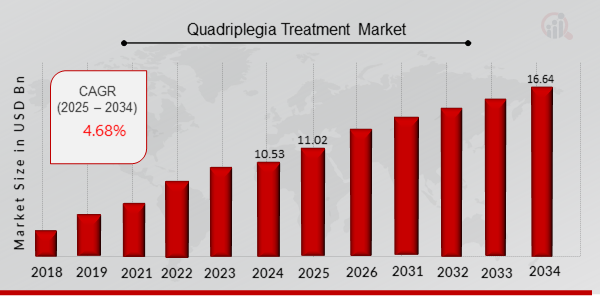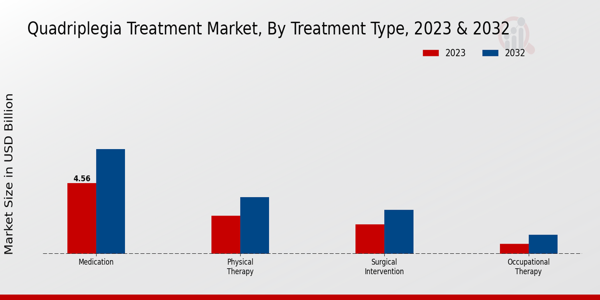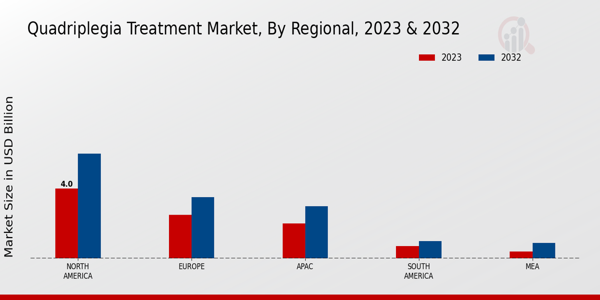Quadriplegia Treatment Market Overview
As per MRFR analysis, the Quadriplegia Treatment Market Size was estimated at 10.53 (USD Billion) in 2024. The Quadriplegia Treatment Market Industry is expected to grow from 11.02 (USD Billion) in 2025 to 16.64 (USD Billion) till 2034, at a CAGR (growth rate) is expected to be around 4.68% during the forecast period (2025 - 2034).
Key Quadriplegia Treatment Market Trends Highlighted
The Quadriplegia Treatment Market is experiencing significant growth driven by several key factors. The rising incidence of spinal cord injuries due to accidents and the increasing prevalence of related diseases are major contributors to the demand for effective treatment solutions. Improvements in healthcare infrastructure and advancements in medical technology have also enhanced the options available for patient care. Furthermore, a growing number of research initiatives aimed at understanding quadriplegia better and developing new therapeutic strategies are fueling innovation in this area. Opportunities in the market are plentiful, especially with the increasing focus on personalized medicine.There is potential for growth in developing tailored treatment plans that cater to the individual needs of patients. Other areas include the enhancement of rehabilitation technologies and the development of assistive devices to improve the quality of life for quadriplegic patients. Additionally, collaborations among healthcare providers, research institutions, and pharmaceutical companies could lead to breakthrough therapies. Recent trends indicate a heightened awareness and advocacy for quadriplegic patients, resulting in better support networks and funding for research. The integration of telemedicine and digital health in managing patient care is also becoming prevalent, allowing for remote monitoring and consultation.Moreover, advancements in stem cell research and regenerative medicine are beginning to show promise in offering new hope for recovery among individuals with quadriplegia. Increased investment in healthcare and the push towards innovative treatment modalities underscore the evolving landscape of this market, making it a focal point for stakeholders seeking to address the challenges faced by those impacted by this condition.

Source: Primary Research, Secondary Research, MRFR Database and Analyst Review
Quadriplegia Treatment Market Drivers
Increasing Prevalence of Quadriplegia
The Quadriplegia Treatment Market Industry is being significantly driven by the increasing prevalence of quadriplegia, a condition that results from spinal cord injuries, neurodegenerative diseases, or congenital malformations. As the global population ages, the incidence of conditions leading to quadriplegia, such as strokes and trauma, is on the rise. This growing patient population requires specialized medical treatments, rehabilitation therapies and assistive devices to improve their quality of life.The need for effective management and care solutions for quadriplegic patients is increasingly becoming a priority, thereby spurring innovation and investment in this sector. The development of advanced treatment modalities, coupled with improved healthcare infrastructure, is further enhancing the ability to address patient needs. Governments and healthcare providers are increasingly acknowledging the chronic and complex nature of quadriplegia, thus allocating more resources toward the Quadriplegia Treatment Market Industry to facilitate the adoption of cutting-edge therapies.Additionally, public awareness campaigns are creating a heightened understanding of quadriplegia and the available treatment options. This comprehensive focus not only promises better patient outcomes but also drives market growth and opens up opportunities for new entries and established players seeking to expand their product offerings in the Quadriplegia Treatment Market.
Advancements in Treatment Technologies
Technological advancements in the medical field have played a pivotal role in the growth of the Quadriplegia Treatment Market Industry. Innovations such as robotics, telemedicine, and regenerative medicine are revolutionizing treatment approaches for quadriplegia. For example, robotic-assisted rehabilitation therapies have proven effective in aiding patients to regain mobility and independence. Furthermore, advancements in stem cell research and other cellular therapies are showing promising results in potentially reversing some effects of spinal cord injuries.Telemedicine is also contributing by providing remote consultation and follow-up care, which is particularly valuable for patients who may have difficulty accessing healthcare facilities. This continuous evolution of treatment technologies is not only enhancing patient outcomes but is also driving market demand, as more healthcare providers are eager to incorporate these new solutions into their practice.
Growing Focus on Rehabilitation and Support Services
The increasing recognition of the importance of rehabilitation and support services for quadriplegic patients is another key driver for the Quadriplegia Treatment Market Industry. Rehabilitation plays a vital role in enhancing the quality of life and independence of individuals with quadriplegia. As healthcare practices evolve, a more holistic approach to treatment, including psychological counseling, occupational therapy and speech therapy, is being developed.This increased focus means that integrated care models are becoming more common, driving demand for comprehensive treatment solutions. Moreover, the rise in chronic disease management programs is also promoting ongoing support for quadriplegic individuals, ensuring they have access to necessary resources even after initial treatment. As these services gain traction, they further contribute to the growth and evolution of the Quadriplegia Treatment Market.
Quadriplegia Treatment Market Segment Insights
Quadriplegia Treatment Market Treatment Type Insights
The Quadriplegia Treatment Market showcases a diverse range of Treatment Types essential for addressing the multifaceted needs of patients. In 2023, the market was poised to achieve a valuation of 9.61 USD Billion, with the segment of Medication leading with a significant share valued at 4.56 USD Billion, reflecting its importance in managing symptoms and improving the quality of life for individuals with quadriplegia. This category is expected to grow to 6.76 USD Billion by 2032, underlining its dominant position as it includes necessary pharmacological interventions that can greatly enhance recovery and management of pain, spasticity, and other complications.Meanwhile, Physical Therapy holds a valuation of 2.48 USD Billion in 2023 and is projected to expand to 3.67 USD Billion by 2032. This segment is vital as it focuses on improving mobility, strength, and independence, and its role is increasingly recognized in spinal cord injury recovery protocols. Surgical Intervention, valued at 1.92 USD Billion in 2023, is another critical segment, anticipated to reach 2.84 USD Billion by 2032. This category includes various surgical procedures necessary for stabilizing the spine or addressing other complications arising from paralysis, illustrating its significant role in the overall treatment landscape.Lastly, Occupational Therapy, while the least dominant segment valued at 0.65 USD Billion in 2023 with a projected growth to 1.23 USD Billion by 2032, remains essential for helping individuals adapt to their living environments and achieve independence in daily activities. Overall, the segmentation of the Quadriplegia Treatment Market by Treatment Type reveals the intricate dynamics and the varied approaches taken to support quadriplegia patients, highlighting the important contributions of each segment in enhancing patient outcomes.

Source: Primary Research, Secondary Research, MRFR Database and Analyst Review
Quadriplegia Treatment Market Application Insights
One prominent area is Pain Management, which addresses the severe pain often experienced by patients, significantly impacting their overall well-being. Rehabilitation is another crucial application, focusing on restoring lost functionalities through tailored therapies, making it a significant contributor to long-term recovery. Moreover, Mobility Assistance is essential for enhancing the independence of individuals and facilitating their movement and daily activities.Additionally, Psychological Support is critical in addressing mental health issues that may arise, providing emotional resilience and coping strategies. Each of these applications reflects a comprehensive approach to quadriplegia treatment, targeting both physical and emotional health needs, thus driving market growth and expansion. The Quadriplegia Treatment Market segmentation into these applications underscores the industry's commitment to holistic care, contributing to the increasing demand and evolving strategies within the market.
Quadriplegia Treatment Market End Use Insights
The Quadriplegia Treatment Market encompasses various end-use settings, namely hospitals, rehabilitation centers, and home care settings, shaping the industry's dynamics and overall growth. Hospitals play a crucial role in providing immediate and advanced medical attention for quadriplegia patients, thereby significantly impacting the Quadriplegia Treatment Market revenue. Rehabilitation centers are equally important, focusing on restoring functionality and improving the quality of life for patients, which leads to sustained market engagement.Furthermore, home care settings are gaining prominence due to the growing preference for personalized care and support in comfortable environments, addressing the physical and emotional needs of patients. The Quadriplegia Treatment Market data shows a shift towards integrating innovative therapies and assistive technologies, enhancing the opportunities for holistic patient management in these settings. Challenges such as accessibility to care and the need for skilled caregivers may hinder growth, yet they also present opportunities for developing specialized services and solutions, driving the market forward.Robust trends toward patient-centric care and an emphasis on long-term rehabilitation continue to shape the competitive landscape of the Quadriplegia Treatment Market industry.
Quadriplegia Treatment Market Patient Age Group Insights
The patient age group is a critical segment influencing market dynamics. The Pediatric age group represents a significant portion of this market, as early intervention in quadriplegia can drastically improve long-term outcomes for children. Innovative therapies and advancements in assistive technologies are crucial in this demographic. The Adult segment tends to dominate the market, driven by higher incidences of accidents and health conditions, thus reflecting a major share of the Quadriplegia Treatment Market revenue.Adult individuals often require extensive management and rehabilitation, leading to a consistent demand for treatment solutions. Meanwhile, the Geriatric group is increasingly relevant as the global population ages, with older adults being prone to conditions leading to quadriplegia. The rising geriatric population is driving significant opportunities for growth in treatment options and care solutions tailored to this segment. Overall, the Quadriplegia Treatment Market data reveals that addressing the unique needs of each age group is essential to capture market potential and enhance patient outcomes.
Quadriplegia Treatment Market Regional Insights
In terms of regional performance, North America dominates with a valuation of 4.0 USD Billion in 2023, projected to grow to 6.0 USD Billion by 2032, highlighting its significant role in the market due to advanced healthcare infrastructure and higher expenditure on medical treatments. Europe follows with a valuation of 2.5 USD Billion in 2023, expected to reach 3.5 USD Billion in 2032, benefitting from growing awareness and innovative treatment options.The Asia-Pacific (APAC) region is valued at 2.0 USD Billion in 2023 and is anticipated to grow to 3.0 USD Billion by 2032, reflecting increasing accessibility to healthcare and rising disposable incomes, though it remains less dominant compared to North America and Europe. South America, with a market value of 0.7 USD Billion in 2023, and the Middle East and Africa (MEA), at 0.41 USD Billion, show potential for growth but face challenges such as limited access to advanced medical facilities and economic constraints. The diversity in regional market performance is a key insight into the Quadriplegia Treatment Market revenue, illustrating varied growth drivers and consumer behaviors across different geographic landscapes.

Source: Primary Research, Secondary Research, MRFR Database and Analyst Review
Quadriplegia Treatment Market Key Players and Competitive Insights
The Quadriplegia Treatment Market is undergoing significant transformation due to increasing awareness, advancements in medical technology, and a rising demand for innovative treatment solutions. Competitive insights into this market reveal a landscape marked by diverse stakeholders, including pharmaceutical companies, medical device manufacturers, and rehabilitation service providers. In this highly competitive arena, key players are focused on developing new therapies and improving existing treatments to cater to the needs of patients with quadriplegia. Collaborations, mergers, and partnerships are prevalent as organizations seek to leverage their strengths and expand their market presence. Research and development initiatives are crucial as companies strive to deliver effective therapies that enhance the quality of life for affected individuals.Curemark is a notable participant within the Quadriplegia Treatment Market, recognized for its innovative therapeutic approaches that cater specifically to the needs of patients dealing with this condition. The company boasts a strong commitment to research and development, focusing on uncovering new pharmacological treatments that can provide relief for those suffering from quadriplegia. Curemark’s strategies are driven by a deep understanding of the market and the unmet needs of patients, which allows it to position itself effectively. Additionally, the company emphasizes the importance of clinical trials, ensuring that its products meet rigorous safety and efficacy standards. The robust pipeline of potential therapies reflects Curemark’s dedication to advancing treatments and its competitive edge in the market, driving the evolution of quadriplegia management.Bristol Myers Squibb, another key player in the Quadriplegia Treatment Market, brings a wealth of experience and a robust portfolio of therapies targeting various health conditions, including neurological disorders that can lead to quadriplegia. The company is renowned for its commitment to research, aiming to discover and develop innovative treatments that alleviate the challenges faced by quadriplegic patients. Bristol Myers Squibb's extensive research facilities and collaborative approach foster partnerships that enhance its capabilities in drug development and market penetration. Its strong presence in global markets, along with a reputation for quality and efficacy, positions Bristol Myers Squibb as a formidable competitor in the quadriplegia treatment landscape, emphasizing its focus on addressing complex medical needs and significantly impacting patient lives through innovative solutions.
Key Companies in the Quadriplegia Treatment Market Include
- Curemark
- Bristol Myers Squibb
- Tetraphase Pharmaceuticals
- Neurotech
- Medtronic
- Reviva Pharmaceuticals
- Thermo Fisher Scientific
- Elekta
- Amedisys
- Life Spine
- Zynex Medical
- Parker Hannifin
- Stryker
Quadriplegia Treatment Market Industry Developments
Recent developments in the Quadriplegia Treatment Market have indicated a growing interest in innovative therapeutic approaches and technologies. Neurotech has been advancing its rehabilitation solutions, utilizing neurostimulation technology to improve mobility and enhance the quality of life for quadriplegic patients. Medtronic is also pushing forward with its research and clinical trials focused on neurovascular therapies aimed at repairing spinal cord injuries.
In addition, Curemark has been expanding its pipeline, exploring new treatment options that target neurological conditions associated with quadriplegia. On the mergers and acquisitions front, companies like Stryker and Zynex Medical have been aligning their strategic interests, although specific transactions have yet to be officially reported. The overall valuation of the market is reportedly on the rise, with significant growth attributed to an increased focus on personalized medicine and advancements in medical device technologies. The proactive stance of companies like Bristol Myers Squibb and Thermo Fisher Scientific in research indicates a robust outlook for stakeholders. These developments reflect an evolving landscape in the Quadriplegia Treatment Market, aiming for improved patient outcomes and enhanced therapeutic options.
Quadriplegia Treatment Market Segmentation Insights
Quadriplegia Treatment Market Treatment Type Outlook
- Medication
- Physical Therapy
- Surgical Intervention
- Occupational Therapy
Quadriplegia Treatment Market Application Outlook
- Pain Management
- Rehabilitation
- Mobility Assistance
- Psychological Support
Quadriplegia Treatment Market End Use Outlook
- Hospitals
- Rehabilitation Centers
- Home Care Settings
Quadriplegia Treatment Market Patient Age Group Outlook
- Pediatric
- Adult
- Geriatric
Quadriplegia Treatment Market Regional Outlook
- North America
- Europe
- South America
- Asia Pacific
- Middle East and Africa
| Report Attribute/Metric |
Details |
|
Market Size 2024
|
10.53 (USD Billion)
|
|
Market Size 2025
|
11.02 (USD Billion)
|
|
Market Size 2034
|
16.64 (USD Billion)
|
|
Compound Annual Growth Rate (CAGR)
|
4.68 % (2025 - 2034)
|
|
Report Coverage
|
Revenue Forecast, Competitive Landscape, Growth Factors, and Trends
|
|
Base Year
|
2024
|
|
Market Forecast Period
|
2025 - 2034
|
|
Historical Data
|
2020 - 2024
|
| Market Forecast Units |
USD Billion |
| Key Companies Profiled |
Curemark, Bristol Myers Squibb, Tetraphase Pharmaceuticals, Neurotech, Medtronic, Reviva Pharmaceuticals, Thermo Fisher Scientific, Elekta, Amedisys, Life Spine, Zynex Medical, Parker Hannifin, Stryker |
| Segments Covered |
Treatment Type, Application, End Use, Patient Age Group, Regional |
| Key Market Opportunities |
1. Telemedicine for remote consultations, 2. Innovative rehabilitation technologies, 3. Personalized medicine advancements, 4. Increased government funding, 5. Growing awareness and education programs |
| Key Market Dynamics |
1. Increasing prevalence of injuries, 2. Advances in medical technology, 3. Growing demand for rehabilitation services, 4. Rising awareness and advocacy efforts, 5. High cost of treatment and care |
| Countries Covered |
North America, Europe, APAC, South America, MEA |
Frequently Asked Questions (FAQ) :
The Quadriplegia Treatment Market was expected to be valued at 16.64 USD Billion in 2034.
The expected CAGR for the Quadriplegia Treatment Market from 2025 to 2034 is 4.68%.
In 2032, North America is anticipated to hold the largest market share at 6.0 USD Billion.
In 2032, the market values for treatment types are 6.76 USD Billion for Medication, 3.67 USD Billion for Physical Therapy, 2.84 USD Billion for Surgical Intervention, and 1.23 USD Billion for Occupational Therapy.
Key players in the market include Curemark, Bristol Myers Squibb, and Medtronic, among others.
The expected market value of the Quadriplegia Treatment Market in North America in 2023 is 4.0 USD Billion.
Anticipated growth opportunities in the market include advancements in treatment technologies and increased investment in healthcare.
The overall market value of the Quadriplegia Treatment Market in 2023 is expected to be 9.61 USD Billion.
The market in Europe is projected to increase from 2.5 USD Billion in 2023 to 3.5 USD Billion in 2032.
Challenges that could impact market growth include high treatment costs and varying healthcare policies across regions.

















